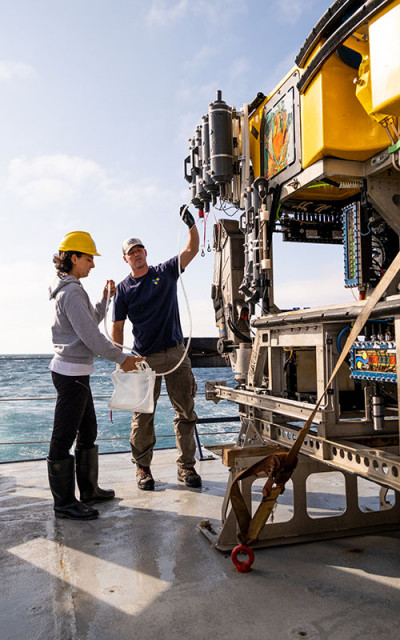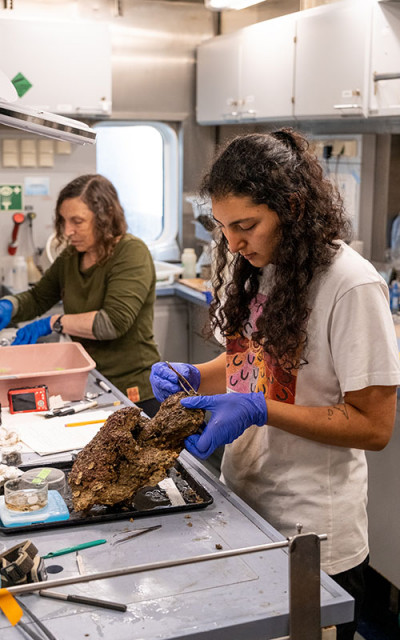Michelle Guraieb is a second-year master’s student studying biological oceanography at Scripps Institution of Oceanography at UC San Diego. She grew up on the outskirts of Mexico City and double majored in marine science and geography at the University of Sydney. Guraieb is currently studying the density, diversity, and community composition of deep-sea macrofauna communities, animals that are one centimeter or more long, and their environmental conditions in the Southern California Borderland, adjacent to southern California and northern Baja California. At Scripps, her advisor is marine ecologist Lisa Levin. Guraieb was also a delegate at COP27, the United Nations Climate Change Conference, and gave a talk about climate change in the deep ocean.
explorations now (en): Why did you choose to attend Scripps?
Michelle Guraieb (MG): After studying marine science in Australia, I knew I wanted to attend graduate school to pursue a career focused on improving the health of our oceans and finding solutions to the many threats the oceans face. When I looked at my options for graduate school, my intent was to find an inspiring advisor who had similar interests to mine, an institution with quality education, and a location where I would feel at home. Scripps fulfills all those things I was looking for.

en: What are you researching at Scripps?
MG: My general research interests center on deep-sea biology and conservation ecology. I am currently researching deep-sea macrofauna communities, which are small animals from 0.5 millimeters to 3 centimeters, that live on hard substrates, such as ferromanganese crusts, basalt and phosphorite rocks in the Southern California Borderland. I am specifically looking at the relationship between the density, diversity, and community composition of these invertebrate communities and the environmental conditions they live in. With the help of experts, I have identified over 3,000 invertebrate specimens from the deep ocean. I am passionate about understanding where different species are found because I think this is the beginning of conservation. The baseline study I am conducting will help us understand the conditions that are contributing to life in the deep sea and could potentially inform policymakers about the use of marine minerals, such as ferromanganese crusts. The animals I have identified will ultimately be preserved at the invertebrate collection at Scripps Oceanography, and they will become time capsules of information for the future, as they map a story of the deep sea during this time.
en: How did you become interested in science and your field of study?
MG: Growing up in Mexico and going to the beach as a kid, I quickly realized that more awareness was needed of the importance of respecting and taking care of the ocean. Over the years, with the lack of environmental measures, misuse of natural resources, and growing human population, I watched the beaches of Mexico change drastically into a more polluted environment. I believe that these issues stem from ignorance about the ocean and its relationship to us in the wider world. I was aware that, at least in some way, these problems in my country were an education issue. Furthermore, in school, I felt passionate about my biology and chemistry classes, which showed me that there is an existing framework we can use to study the natural world and come up with solutions to the very problems I noticed as a kid. My experiences with nature and the ocean have inspired me to pursue a scientific career in hopes of educating the public and influencing policy to enhance protection of the natural world.
en: What’s life like as a Scripps student? Describe a typical day.
MG: As a deep-sea biology master’s student, I spent most of my first 1.5 years in the lab identifying specimens and taking classes. My days looked like a mix of attending lectures and spending time in the lab. Sometimes I paired that with a short break by going for a walk at the beach or the Scripps Coastal Meander Trailhead. This past summer, I have mostly been spending my days working at the desk analyzing my data, reading papers, and writing my thesis. I love pairing my days with fun activities like going for a swim around the pier or a run at the beach.

en: What’s the most exciting thing about your work (in the field or in the lab)?
MG: Because the deep ocean is hard to access and challenging to study, it is a very understudied area of research that provides a lot of room for exploration and groundbreaking discoveries. In the lab, I get most excited when I find challenging specimens to identify because it may require me to reach out to other experts which helps expand my knowledge. One of the most exciting things about my work at Scripps has been getting the chance to go on oceanographic expeditions and conferences. Last year I had the chance to attend COP27, the UN climate change conference, and give a talk about climate change in the deep ocean. This was an incredible experience that allowed me to see first-hand how science can influence policy. This summer, I went on a deep-sea cruise to study methane seeps off the coast of California and I got to dive 400 meters deep in a submersible for the first time!
en: Are there any role models or mentors who have helped you along the way?
MG: My advisor, Lisa Levin, has definitely been a role model and mentor to me. She has helped me navigate graduate school and she inspires me with the way she is involved in policy and science at the same time. Lisa is not only a role model because of her knowledge and the way she does science, but also as a person who has paved the way for other women in STEM. She is always supportive and believes in my capabilities, giving me enough freedom to make my own decisions and mentoring me at the same time. I will always be grateful to Olívia Pereira, a PhD student in my lab, who has supported me as a mentor and friend. My lab mates are also amazing people who inspire and motivate me. And last but not least, my parents, who have always encouraged and supported me to pursue my dreams.

en: What are some of the challenges you face as a student?
MG: Some challenges of being a student involve managing my time wisely, especially to fit in working as a teaching assistant. One big challenge has also been finishing my lab work, which was a bit more time-consuming than we initially thought. However, my advisor has been very supportive and we have been able to work around these difficulties.
en: What are your plans post-Scripps?
MG: I am still considering my options for post-graduation. I am interested in staying in the field of deep-sea science so I am currently looking for jobs in the area and considering pursuing a PhD.
You can find Guraieb on Instagram @michelleguri and @deepseascience, her science communication account that is co-managed with another master's student.